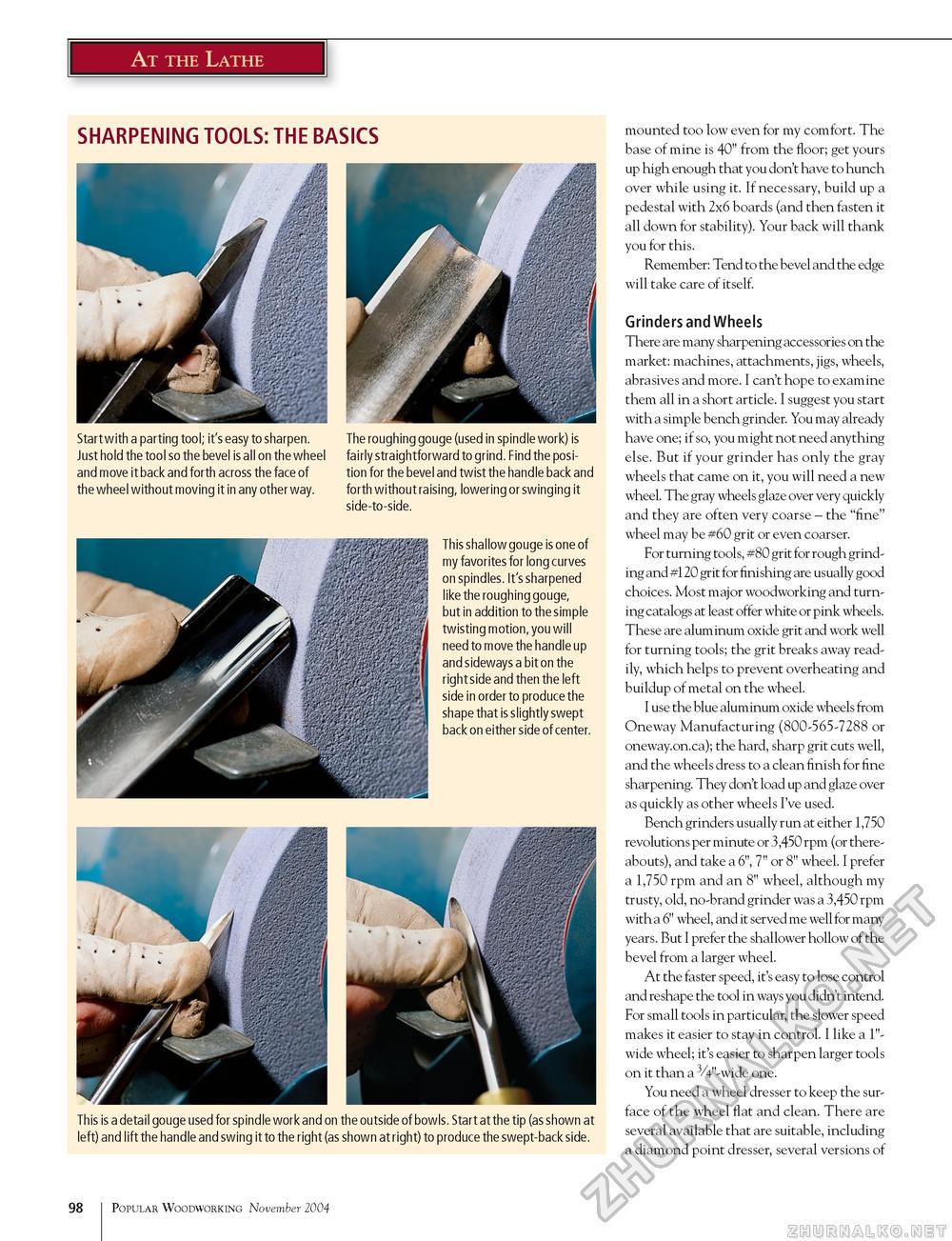Popular Woodworking 2004-11 № 144, страница 99
At the Lathe SHARPENING TOOLS: THE BASICS Start with a parting tool; it's easy to sharpen. Just hold the tool so the bevel is all on the wheel and move it back and forth across the face of the wheel without moving it in any other way. The roughing gouge (used in spindle work) is fairly straightforward to grind. Find the position for the bevel and twist the handle back and forth without raising, lowering or swinging it side-to-side. This shallow gouge is one of my favorites for long curves on spindles. It's sharpened like the roughing gouge, but in addition to the simple twisting motion, you will need to move the handle up and sideways a bit on the right side and then the left side in order to produce the shape that is slightly swept back on either side of center. This is a detail gouge used for spindle work and on the outside of bowls. Start at the tip (as shown at left) and lift the handle and swing it to the right (as shown at right) to produce the swept-back side. mounted too low even for my comfort. The base of mine is 40" from the floor; get yours up high enough that you don't have to hunch over while using it. If necessary, build up a pedestal with 2x6 boards (and then fasten it all down for stability). Your back will thank you for this. Remember: Tend to the bevel and the edge will take care of itself. Grinders and Wheels There are many sharpening accessories on the market: machines, attachments, jigs, wheels, abrasives and more. I can't hope to examine them all in a short article. I suggest you start with a simple bench grinder. You may already have one; if so, you might not need anything else. But if your grinder has only the gray wheels that came on it, you will need a new wheel. The gray wheels glaze over very quickly and they are often very coarse - the "fine" wheel may be #60 grit or even coarser. For turning tools, #80 grit for rough grinding and #120 grit for finishing are usually good choices. Most major woodworking and turning catalogs at least offer white or pink wheels. These are aluminum oxide grit and work well for turning tools; the grit breaks away readily, which helps to prevent overheating and buildup of metal on the wheel. I use the blue aluminum oxide wheels from Oneway Manufacturing (800-565-7288 or oneway.on.ca); the hard, sharp grit cuts well, and the wheels dress to a clean finish for fine sharpening. They don't load up and glaze over as quickly as other wheels I've used. Bench grinders usually run at either 1,750 revolutions per minute or3,450 rpm (or thereabouts), and take a 6", 7" or 8" wheel. I prefer a 1,750 rpm and an 8" wheel, although my trusty, old, no-brand grinder was a 3,450 rpm with a 6" wheel, and it served me well for many years. But I prefer the shallower hollow of the bevel from a larger wheel. At the faster speed, it's easy to lose control and reshape the tool in ways you didn't intend. For small tools in particular, the slower speed makes it easier to stay in control. I like a 1"-wide wheel; it's easier to sharpen larger tools on it than a 3/4"-wide one. You need a wheel dresser to keep the surface of the wheel flat and clean. There are several available that are suitable, including a diamond point dresser, several versions of 98 Popular Woodworking November 2004 |








